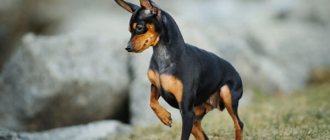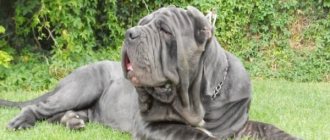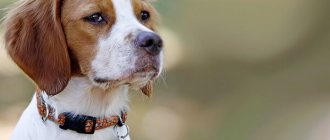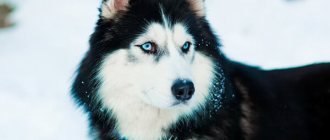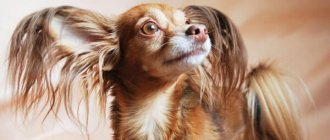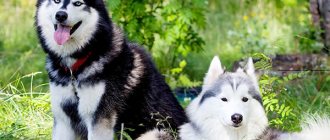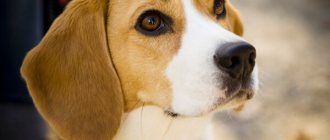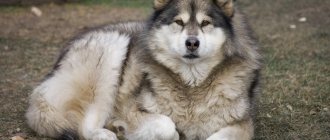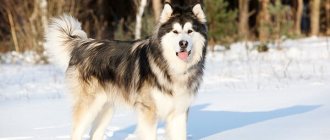The dachshund is a representative of one of the oldest breeds, whose goal was to find and drive burrowing animals.
Dogs have evolved the ability to chase prey over centuries.
Therefore, it is not surprising that the appearance of the animal speaks for itself.
The dogs have an elongated body and short legs, and their squat stature is one of the advantages of these dogs in the field of burrow hunting.
In this article we will give a detailed description of the long-haired dachshund breed and how to care for them.
Origin story
All short dogs with a long body, as a rule, have one ancestor - ancient hounds. And the dachshund is no exception.
But in relation to hounds, a long body was recognized as a disadvantage rather than an advantage - only the long-legged hound was recognized, until this type was used in the field of burrow hunting. For the first time, the disproportionate ratio of the body to the legs was appreciated by German hunters and only later by breeders, from whom the targeted breeding of squat dogs began.
NOTE!
A larger number of remains of dachshund dogs were found in Germany. However, during excavations, skeletons of early dachshunds were also discovered in Greece, Ancient Rome and Egypt.
With the official recognition of the breed (1988), the number of breeders increased, which led to the active spread of the breed throughout the world. Therefore, it is not surprising that active export led to the formation of subspecies of the breed.
For example, the standard longhaired dachshund was created by crossing spaniels with the standard dachshund.
Long-haired rabbit - by mating small dwarf dachshunds, pinschers and toy terriers.
The long-haired dwarf was bred by mating small representatives of the standard long-haired dachshund.
Compared to males, females are characterized by elegance both in terms of head and body. The physique of females is more toned. In terms of height and body length, gender does not play a role, so the proportions remain the same: 1.7-1.8:1.
Interesting Facts
There are many interesting facts associated with this breed. For example:
- In 2009, a dachshund named Chanel lived for 21 years, so she was included in the Guinness Book of Records.
- The American Kennel Club classifies this breed as a hunting breed. And this is well deserved, because dachshunds are agile, hardy, fast and nimble. It will not be difficult for them to track, catch up and destroy prey.
- In German, the dachshund is called dachshund, which means badger dog. Representatives of this breed were used to hunt badgers and other fur-bearing animals. For this they were highly valued.
- Dachshunds are gluttons. Despite their small size, these dogs have an enviable appetite.
- Dogs of this breed participated in the expeditions of Jean Yves Cousteau. The writer Anton Pavlovich Chekhov was also a fan of this breed; he had two dachshunds.
Character traits
The character of the long-haired dachshund does not differ much from other representatives of the breed. Along with other relatives, this species is not devoid of hunting traits and is ready to play the role of a guard along with other dogs.
Well oriented in space. This can be understood by the speed with which the dog takes up all the warm and cozy places in the house.
She is also not devoid of a sense of ownership. Therefore, if the owner, without good reason, reaches out to the object the dachshund has chosen, be prepared for a warning growl. A sense of ownership also manifests itself in relation to territory. Most dachshunds show genuine wariness when welcoming new guests into the house.
Expert opinion
Kozhevin Semyon Kirillovich
Expert dog handler.
The first thing that strikes you is character. While other dachshund cousins are stubborn, the long-haired dachshund is characterized by a delicate approach. But, despite its gentleness, the dachshund remains true to its nature and can compromise its principles if circumstances contribute to this. For example, danger. After all, the dachshund is a territorial animal.
Vaccinations and susceptibility to disease
The average life expectancy of long-haired dachshunds is 15-16 years. However, it largely depends on how carefully the dog owner takes care of its health. The so-called Achilles heel of the long-haired dachshund is the spine. It is subjected to a lot of stress due to the special structure of the body.
The following signs indicate incipient back problems:
- the dachshund experiences pain when pressing on the lower back;
- lameness;
- restless behavior.
If these symptoms are present, the dog should be taken to the veterinarian. Problems with the spine can lead to paralysis of the legs.
Other common diseases of long-haired dachshunds:
- obesity;
- epilepsy;
- conjunctivitis;
- allergy.
To prevent a long-haired dachshund from becoming infected with an infectious disease, it is necessary to vaccinate in a timely manner. The first vaccinations are given at the nursery; the veterinarian will tell you about the further immunization schedule.
The dog must be vaccinated against the following diseases:
- plague;
- enteritis;
- hepatitis;
- rabies;
- leptospirosis.
Important! The long-haired dachshund must be regularly treated for ectoparasites and worms. Fleas, lice eaters and ticks are carriers of infectious diseases and some types of helminthiasis.
Wool and its structure
The dachshund's coat is smooth, even, and shines in the light. It fits tightly to the body, in the area of the throat and lower part of the body the hair is longer, while on the muzzle it is shorter and thick.
If the fur is wavy on the line of the belly and chest, then on the ears it is observed in the form of a fringe. But the fur reaches its greatest length on the underside of the tail, where it resembles a real flag.
Buy a rabbit dachshund
As mentioned above, first of all, you should think a hundred times before getting a dog at home, no matter what breed.
What to pay attention to
Purchasing a dog involves a number of key points that can ensure that you purchase a healthy animal. First of all, you should decide on the place of purchase, since the reputation of the breeder plays a huge role. This is very important, since only at one and a half years old the animal will resemble a rabbit dachshund. As a result of a visual examination, you can determine how cheerful, inquisitive the puppy is, has a healthy coat, without any flaws (visible), and also how well-fed it is. Often, puppies are deliberately not given enough food to meet all standards. In fact, this should not be done, since the animal will not have a healthy appearance.
Price of a rabbit dachshund
In our country, this breed is considered quite rare, and therefore not cheap. You should aim for about 20 thousand rubles if the puppy is truly purebred. The maximum cost of puppies of this breed is in the range of 100-150 thousand rubles, which may correspond to the “Show” class. When buying on the market for 3-5 thousand, you should not count on the fact that the puppy has a bright pedigree.
Accepted standard
The table below shows the standard characteristics of a longhaired dachshund:
| Index | Description |
| Head | Triangular in shape, but not narrow. The forehead is wide, with a marked transition to the muzzle. Developed and strong jaws. |
| Eyes | Small, evenly placed. The predominant palette is brown; pearl and blue are also found. |
| Nose | The lobe is oval in shape, colored brown or black. |
| Ears | Wide, drooping and with rounded tips |
| Teeth | Complete dentition. The teeth are white, even, with large fangs. |
| Body | Muscular, strong, with a deep or pear-shaped chest. |
| Limbs | Well developed joints. The front legs are set closer together than the hind legs. |
| Tail | Continues the line of the spine and is not restricted in movements. |
Purpose
The main purpose of the dog is to hunt badgers, hares, and harmful rodents. The standards for a long-haired dachshund include an elongated head without any points, evenly tapering towards the tip of the nose, and a flat skull. The body is muscular, strong, chest in front, tucked in belly. The paws are bony and muscular. These parameters allow the hunter-dog to penetrate into holes and survive animals and pests.
She can also be a watchman: distrust of strangers is manifested by loud warning barks. The ability to live in an apartment, the qualities of a watchman, and unpretentiousness allow her to be a companion and a family favorite.
Dimensions and weight
Common sizes:
| Options | Male | Bitch |
| Height at withers | 27-22 cm | 25-20 cm |
| Weight | 9 kg | Up to 9 kg |
| Size (bust) | More than 35 cm | Up to 35 cm and above |
IMPORTANT!
Standard dachshunds weighing more than 9 kg are not subject to rejection, but do not receive an “excellent” rating. As for obese dachshunds, they are immediately recognized as a marriage.
Breed characteristics
During the existence of the species, neither the character nor the appearance of dogs of this breed changed practically. Smooth-haired dachshund or with wool - it doesn’t really matter. The main thing is that both types have literally outstanding qualities:
- The dog can easily endure any difficulties.
- The fluffy dachshund has a lively disposition.
- It is better to train a dog from an early age.
- Bonds to only one owner.
- The shaggy dachshund breed looks very funny.
What is the difference from a smooth-haired dachshund?
The smooth-haired dachshund has short, thick, sometimes hard and close-fitting hair; in comparison, the long-haired dachshund has smooth hair and has undercoat. The length of the coat varies depending on the area of the body. If on the lower part of the body the hairline calmly falls down, then on the throat it goes down in the form of a small beard, when the ears are framed with fringe.
The smooth-haired dachshund has three color :
- single color (black, red, beige, etc.);
- two-color;
- marble and brindle.
When, like a long-haired dog, only the first and third options are considered.
Reviews from owners of curly dachshunds
Nika, Moscow:
“A magnificent, stately and beautiful dog. She quickly learns commands and deftly performs tricks. Working with her is a pleasure. The main thing is to have patience and understanding, and then your friend will answer you in kind. A daily walk is our favorite time. And cold weather won’t interfere with this if you have warm overalls.”
Albina, Krasnodar:
“When we arrived at the kennel, I was immediately hooked by this particular dog. Four years have passed since then, and I have never regretted the decision to take her. I always monitor her diet and health to prevent any illnesses. Feeding is easy because we ourselves eat the same natural foods. The dog is incredibly energetic and never sits still. There is not a single corner of the house where he has not visited.”
Photos of main colors
Among the single-color colors of the long-haired dachshund, red (the most valuable), red, fawn and brown are common, which are also not without dark hairs. Regarding the white color, the situation is not clear; on the one hand, this color is not desirable, but rare white spots are still acceptable.
Among others, marble and tiger colors are often observed. In marble, a dark shade predominates (gray, red, black) and small beige and gray spots are welcome. The brindle color is based on red or fawn.
NOTE!
The value of a color is determined by its saturation.
Hunting
The long-haired variety of Dachshunds was bred at a time when the breed was no longer considered a purely working breed. The shiny coat and pretty appearance should have aroused additional interest among dog lovers living in apartments. Long-haired Dachshunds were almost never used for hunting, although their working characteristics are in no way inferior to smooth-haired and wire-haired dogs.
Obtaining permission to hunt involves several stages. The first of them is an exam on the OKD (general training course), then comes training in shooting and, after that, training in an artificial hole. After successfully passing the working tests, the Dachshund receives a certificate and is allowed to work.
Note! Dogs without pedigrees (at least zero) cannot receive a working certificate and are not allowed to hunt.
In addition to burrow hunting, Dachshunds have instincts for driving animals. Typically, standard-sized dogs are used for this purpose. To be fair, we note that long-haired dogs are not used as hounds, but obtaining permission is not excluded. Only the owner can decide which animal his pet will work on. Dachshunds successfully cope with corralling hare, fox, ungulates and even wild boar.
Advantages and disadvantages
Positive aspects of the breed:
- intelligence;
- mind;
- loyal attitude towards others;
- endurance;
- attachment;
- courage and good makings of a security guard;
- innate hunting qualities;
- compactness.
Negative:
- jealousy and resentment;
- tendency to dominate;
- tendency to obesity;
- difficulties with training;
- predisposition to diseases.
Dossier
Height: standard at the withers - 20-30 cm, dwarf 14-21 cm, rabbit 10-13 cm. Weight: standard - from 7 to 10 kg, dwarf 14-21 cm, rabbit up to 3.5 kg. Characteristic color: solid red, reddish-yellow, fawn; two-tone dark, black or brown; marble gray, brindle. Coat length: long, flowing, thick with dense undercoat, 1-3 cm. Life expectancy: from 12 to 16 years. Advantages of the breed: affection for the owner, ideal for families, excellent friend to children, loyal to other animals, smart. Difficulties of the breed: stubborn, prone to dominance, noisy, digs the ground, voracious, prone to obesity, spinal diseases, sexual hyperactivity in males. Average price of a longhaired dachshund: $300 to $500. Classification: hunting, apartment, companion, family.
Life expectancy and health
On average, long-haired dachshunds live 10-15 years. The basis for the length of years is the conditions of detention and genetic heredity.
Dachshunds are one of those dogs that are prone to a number of diseases:
- diseases of the musculoskeletal system;
- diseases of the spine (pinched spinal nerves);
- intestinal diseases (urolithiasis);
- heart and kidney diseases;
- hormonal disorders;
- hernia;
- diabetes;
- dysplasia;
- eye diseases (cataracts and glaucoma);
- obesity;
- osteochondrosis;
- colds and hypothermia;
- Swimmer's or turtle chest syndrome.
The rabbit variety of dachshunds is prone to ailments that affect all miniature dogs:
- skin diseases;
- atlantoaxial instability (displacement of the second cervical vertebra relative to the first);
- hypoglycemia (lack of blood sugar levels);
- problems with the muscle corset;
- Difficulty in replacing baby teeth with molars.
Caring for Longhaired Dachshunds
Naturally, the long hair of these dogs requires more careful care than their short-haired counterparts. Owners need to comb it regularly, and will also need periodic haircuts, including hygienic ones - cutting off areas between the fingers, inside the ears, and in the groin.
If the pet is not a working dog, then its nails should be trimmed as necessary. These little hunters are prone to gaining excess weight, so they need regular active walks. You need to constantly play with them, run around, and not let them get bored.
The long-haired dachshund, like other dogs, requires mandatory vaccination, deworming, and treatment for fleas and other external parasites.
Basic rules of care
The dog's coat is soft and not devoid of the ability to wear out, so hair care requires consistent brushing at least several times a week, followed by combing out the undercoat. A bristle brush and a wide-tooth comb help with this.
The eyes are regularly checked for accumulated dirt and secretions, which are promptly removed with a dampened cloth.
Dirt and wax are also removed from the ears, but using a cotton swab so as not to damage the ear canals.
In dental care, it is recommended to buy special pastes and gels, which, at the same time as cleaning, provide prevention against various diseases.
Nails are trimmed every 2 weeks or as they grow. Make sure that there is no damage to the claw tissue.
IMPORTANT!
Most owners are inclined to buy overalls, but this type of clothing has a bad effect on both the pet’s hair and gait. Not recommended for show dogs.
Care and maintenance of an adult dog
Caring for a longhaired dachshund is no more difficult than caring for any other dog. She needs very little:
- good nutrition;
- regular walking;
- physical exercise;
- training;
- body and coat care.
The right diet
The long-haired dachshund can be fed both natural food and store-bought food. In the first case, the owner will have to create his own diet.
The dog's menu should contain the following products:
- boiled or steamed cereals - rice, buckwheat;
- lean meats and offal;
- fermented milk products – kefir, cottage cheese;
- vegetables;
- fruits and berries (in small quantities);
- sea fish (once a week);
- eggs.
An adult long-haired dachshund is fed morning and evening. You can’t follow the lead of a little beggar every time he looks with a sad look at the food on his household’s plate. A tendency to gluttony can play a cruel joke on a dog - it will lead to excess weight gain and health problems.
List of prohibited products:
- pork;
- salo;
- raw meat;
- sweets – chocolate, candies;
- baking;
- bones;
- margarine;
- fat sour cream;
- smoked meats;
- canned vegetables.
From store-bought feeds, those that belong to the super-premium or holistic class are preferable. They contain meat, grains, beans and vegetables in the right proportions, all the necessary vitamins and microelements.
Attention! Dachshunds that eat properly have a healthy shine to their coat.
Walking and physical activity
The dachshund is an active dog. If you don’t give her enough attention and don’t give her the opportunity to run around while she’s out for a walk, the animal owner may have problems. A characteristic feature of this breed is its need to dig. If she is not satisfied, the pet will chew the upholstered furniture out of boredom.
The only way out is to give the dog such a load that it has no strength left for destructive activities.
What activities will a long-haired dachshund enjoy and benefit it from?
- Swimming strengthens muscles and does not create stress on the back, which is a weak point in representatives of this breed.
- Cross country running. However, you should not allow your dog to jump high.
- Visit a baiting station, if there is one nearby.
A long-haired dachshund should be walked every day if possible. The exception is days when there is heavy rain or gusty winds. The minimum duration of the walk is 40 minutes.
Training and education
You need to start training a dachshund puppy from the first days of its stay in the house, as soon as the dog gets used to its new place. It is important to immediately determine the boundaries of what is permitted. From an early age, the Dachshund must learn the rules to follow at home.
Attention! Unwanted puppy behavior cannot be ignored, otherwise the dog will have bad manners for life.
The pet should be taught to go to the toilet in a diaper. When the quarantine period after vaccination is over, you can go for a walk outside. At this time, it is worth introducing the baby to a leash and collar.
Training should take place in a playful way. However, before you start, it is important to establish a trusting relationship with your dachshund. Achievement and obedience should be praised and rewarded. For his part, the owner must remain calm and not be overly strict, otherwise the dog will grow up cowardly. To achieve better results, you should sign up for classes with a dog trainer.
Care and hygiene
The long-haired dachshund needs good care. Its cover requires special attention. It is also necessary to monitor the condition of the eyes, ears, teeth and claws.
Wool
To keep your long-haired dachshund's coat looking luxurious and shining with a healthy shine, the dog needs to be brushed daily. First use a brush and then a comb. Wool should be washed at least once a week. But it is not recommended to use detergents so often, as they disrupt the natural alkaline balance of the skin. A dachshund can be bathed with shampoo 5-6 times a year. From time to time you will have to contact a groomer to have the hair between the toes, ears and groin area hygienically trimmed.
Eyes
Dirt collects in the corners of the animal's eyes. It should be removed every day using a cotton pad or a piece of bandage soaked in warm water. To care for the eyes, you can use special hygiene lotions for dogs and cats.
Ears
Caring for your pet includes checking the ears. Sulfur and dust particles accumulate there. Cotton swabs are not suitable for cleaning sinks - they can easily damage the eardrum. It is better to clean the external auditory canal with a cotton swab soaked in petroleum jelly or hydrogen peroxide.
Teeth
After replacing baby teeth with permanent ones, it is important to make it a rule to monitor oral hygiene. Pet stores sell special pastes for animals and brushes that you can put on your finger. Teeth brushing is done once a week. To prevent the formation of tartar, your long-haired dachshund should be given solid treats.
Claws
Dogs' claws do not grow very quickly. In pets who often walk outside for a long time, they have time to wear down. If they become too long and start to knock on the floor, they should be shortened. To carry out the procedure you will need a nail clipper. With its help, only the tip 1 mm long is removed. The main thing is not to cut too much and not affect living tissue with blood vessels.
How to feed?
The serving size is based on the pet's body weight in the ratio of 45 grams per 1 kg of weight. Due to physiological characteristics, a dog’s diet should be rich in fats and proteins. Therefore, it is advised to approach both the choice of dry food and natural food with equal criticality.
In terms of natural feeding, it is recommended to adhere to:
- porridge, vegetable and meat broths (40%);
- in terms of cereals – rice and buckwheat (20-40%);
- Fermented milk products include kefir, fermented baked milk, cottage cheese, etc.;
- vegetables and fruits (40%).
Prohibited products:
- raw meat;
- boiled bones;
- potato;
- spices;
- spices;
- smoked meats;
- flour and confectionery products.
Dachshund diet
The dachshund's diet contains the following products:
- Meat. A third of a dachshund's diet consists of meat. Lean lamb, turkey and lean beef are preferred. Chicken meat can cause allergies, fatty pork can cause intestinal upset. Remember, the meat is served boiled to avoid the possibility of helminth infection. If you are confident in the quality of the meat, it is permissible to give it raw or pour boiling water over it. From 3 months of age, by-products are introduced.
- Fish. It is possible to periodically replace meat by-products with fish. It is advisable to choose sea fish that has been cleaned of sharp bones. It is not advisable to give river fish.
- Cereals make up 20–40% of a dachshund’s daily diet. Among cereals, preference should be given to rice, buckwheat, oats or rolled oats. Sometimes it is possible to include other grains in the diet to saturate the body with microelements. When preparing porridge for your dachshund, remember that millet can weaken you, legumes can cause bloating, and pearl barley is digested by less than a third. You should not give semolina porridge. It causes intestinal dysfunction and, due to its calorie content, leads to obesity.
- Fruits and vegetables. When thinking about what to feed your dachshund, don’t forget about vegetables. Up to half of the diet consists of vegetables; this is an excellent source of vitamins, fiber and carbohydrates. It is advisable for the dog to eat vegetables raw, chopped on a grater. Selected vegetables are given only after heat treatment. For example, difficult-to-digest potatoes are given boiled, as rarely as possible. Cabbage causes fermentation in the intestines, it is better to stew it. Dachshunds love fruit in any form. It is worth limiting the consumption of exotic fruits and aromatic greens such as cilantro or celery.
The dachshund's diet will become more varied due to the introduction of dairy products into the diet. Milk in its pure form is given exclusively to puppies up to 3-4 months. Then lactose ceases to be absorbed in the dachshund’s body. Dairy products in the diet of an adult dog are presented in the form of kefir, yogurt, cottage cheese, cheeses, fermented baked milk and yogurt. If the question is what to feed a 2-month-old dachshund, remember about dairy products.
The dachshund's diet includes eggs, no more than 1-2 eggs per week. Serve boiled or as an omelet. It is possible for puppies and pregnant bitches to eat raw quail eggs. Sometimes they offer seafood. You should not give baked goods and sweet pastries. The dishes are too high in calories. It is acceptable to pamper your dachshund with rye crackers. Try to avoid giving foods containing sugar. Be sure to add vegetable oil to your pet's food. Dachshunds enjoy eating such dishes; oil is a source of amino acids.
Owners of puppies of this breed often wonder what to feed their dachshund puppy. For a puppy up to 4 months old, the basis of the diet will be fresh cow's milk. Later the diet changes. Porridges with meat and vegetables predominate. The food is served warm and fresh.
Education and training
The training period begins from the moment the puppy gets used to its name and gets used to its owner. During the training process, you should be assertive and adhere to a clear sequence of actions.
In order not to move from one lesson to another without consolidating the result, but to refine the skill until it is completely memorized. It is worth clarifying that dachshunds know how to elicit pity, and if this problem is not nipped in the bud, then the dog will subsequently explore the full range of possibilities for manipulating the owner.
Dogs are also prone to obesity, so treats for pets should not become part of the diet, but be used exclusively as a means of encouragement. Dogs react subtly to intonation and emotional coloring of sentences, so distinguishing praise from reprimand is not a problem for them.
Diseases and treatment
Dachshunds are one of the few dogs prone to allergies. Itching and dandruff appear when “wrong” foods are introduced into a pet’s diet. A similar reaction, as well as weak stools, is provoked by a sharp transition to a new menu.
Expert opinion
Anna Abramenko
An avid dog lover. Experience in veterinary medicine since 2009.
Ask a Question
Puppies should not jump a lot and do vertical stands. Such movements during games or training lead to displacement of the spinal discs and the development of a hernia in dogs, which affects the posture of dachshunds. Due to the specific body structure of the breed, this is a common health problem for these dogs.
The breed is susceptible to other diseases. What do dachshunds get sick with?
| Name | Description | What to do |
| Intervertebral hernia | The pain comes unexpectedly. The decline in activity occurs instantly or occurs gradually. Usually the hind legs fail. Over time, the animal loses control of urination | After the examination, the veterinarian prescribes conservative treatment (medicines, physical procedures, massages) or resorts to surgical intervention |
| Osteoporosis | Puppies get sick more often, and the reason lies in the wrong menu, lack of vitamin D, and rare walks. If the baby moves on his stomach because his paws are moving apart, this is a clear sign of the disease. | Balance the menu, introduce healthy ingredients into the diet, expose them to the sun more often |
| Acanthosis nigricans | The skin is affected, turning into an elephantine skin - with hanging thick folds. Foci of the disease appear on the abdomen, thighs, chest, and armpits. In these places, the hair falls out completely and the pigmentation changes. Scientists have not yet figured out the true cause of the disease. Some people think it’s genetics, while others blame it on endocrinology. But everyone agrees on one thing - stress is the impetus. | Therapy consists of treatment with corticosteroids, the use of special shampoos and ointments containing tar, sulfur, vitamin A. Preventive measures are important - hypoallergenic nutrition, avoidance of stressful situations |
| Otodectosis | The first symptom is severe itching, causing the dog to scratch. Dark crusts are visible at the site of sores in the ears | The best product is Vectra 3D |
Specific pathologies can be avoided if you provide your pet with proper care in compliance with the regimens.
What do the puppies look like?
The weight of a dachshund puppy at 2 months is reduced to 2-3 kg, at 3 months it is already exactly 3 kg. If at the age of two months the puppy weighs less or more than 3-4 kg, then according to the standard this is recognized as a defect.
However, the appearance of the pet is formed over the course of 16-24 months, and according to dog handlers, changes in the animal’s coat take even longer – up to 4 years. For the first few weeks, puppies are covered with fluff, so it is difficult to guess the color and type of coat. This will be possible only by 5-8 months, when the puppy begins to grow fur.
Dachshund puppy cost
Hairy breed dachshunds are offered by cynological centers in Russia operating in Moscow, St. Petersburg and Yekaterinburg. Private breeders are also involved in breeding short-legged dogs. Therefore, puppy prices fluctuate.
- Titled dachshund babies bred for exhibitions cost 60 thousand rubles.
- Miniature varieties of long-haired dogs cost a little less - 30-40 thousand rubles.
- The price of purebreds with documents is 15-20 thousand.
If the passport and pedigree of the dog do not matter, then you can look at the bird market. Here the price for puppies starts from 2-5 thousand rubles.
Grooming at home
Before you start, it is advised to take care of the location where grooming will take place - be it a special table or a floor covered with a towel.
The fur is moistened with an even layer of a mixture of water and conditioner in a ratio of 3/4 to 1/4 and carefully combed out using a comb-brush. Then using a flat comb, a slicker brush and a bristle brush.
During the molting period, it is recommended to use a furminator.
Bathing is carried out with the participation of shampoo and conditioner (in turns), which are finally thoroughly washed off so as not to damage the dog’s skin.
After bathing, grooming scissors are used to trim the ends of the tail. Using regular scissors can lead to thinning hair, so be careful.
Price range and nurseries
The problem is that, despite the popularity of long-haired dachshunds, not every city has kennels willing to provide breeder services. Therefore, be prepared to purposefully go after your future four-legged friend.
The cost of a puppy without documents starts from 5 thousand rubles, while with a pedigree it starts from 20 thousand rubles. Among all the subspecies of dachshunds, the rabbit is the most expensive, reaching an average of 50 thousand rubles. This is explained by the popularity of small dogs, which also produce fewer puppies (2-3 in one litter).
Below are popular nurseries that breed long-haired dachshunds:
- "From the Cherry Grove";
- "Country of Limonia"
Relationship with children and other animals
If other animals live under the same roof as a long-haired four-legged friend, he will treat them positively. But at the sight of tiny rodents, your pet’s hunter’s instincts may kick in. But the shaggy dachshund will snap at strangers and strangers, and may even attack. She will perceive them as a potential threat that needs to be gotten rid of.
The longhaired dachshund gets along well with children. But you should not let it close to very young children, because through carelessness the pet can harm or injure the child.
How to choose your future pet?
When choosing, it is recommended to pay attention to the following details:
- Pet grooming. Condition of the nose, ears, fur (no bald spots).
- Activity. From a young age, Dachshund puppies demonstrate mobility and a willingness to explore the world around them. Healthy puppies sparkle with energy and do not shy away from strangers.
- Body proportions. The back is not sagging, straight.
- The tail is slightly lowered, without bending.
- The eyes are small and shiny. With a clear and friendly look.
Among long-haired dachshunds, it is also undesirable to have a parting on the back and a lack of feathering on the tail (dewlap) and ears (fringe). Be prepared to pay attention to defects in your pet's anatomy - long legs, incorrect placement of limbs, undermining of the groin. Among breeders, such deficiencies are severely punished.
Description
Since the 17th century, Germany has been looking at short-legged dogs for burrow hunting. In just one century, varieties of elongated dogs appeared, which were already bred outside the country. This was the reason for the approval of breed standards.
Varieties
Since the 19th century, representatives of short-legged hounds have become pets everywhere. In selection, a new direction emerges - breeding miniature dogs. Among long-haired dachshunds, 3 varieties with chest volume appear:
- standard – more than 35 cm;
- “dwarfs” – 30-35 cm;
- “rabbits” – up to 30 cm.
This is the main parameter by which representatives of species are assessed. Such dogs are further divided into 2 types - large dachshunds (8-12 kg) and small ones (6-8 kg). Miniature animals, accordingly, have even less mass.
Otherwise, the characteristics are identical: a well-defined keel on the deep sternum, an elongated body and muzzle, short legs, excessively hairy ears and tail.
Expert opinion
Anna Abramenko
An avid dog lover. Experience in veterinary medicine since 2009.
Ask a Question
Dachshunds have different personalities. If the standard one is more playful and docile, then small representatives of the breed are characterized by aggression.
Characteristics of the Dachshund
When purchasing a dog, many people want to be sure of its purebred. Each species has certain characteristics. The long-haired standard dachshund also has them.
Read the article: Breeds of long-haired dogs
- The head is triangular, but without points, with a narrowed muzzle.
- The neck is muscular, with pronounced withers.
- The transition from the forehead to the nose is fuzzy, all lines are smoothed out.
- The brow ridges and cheekbones stand out sharply.
- The eyes are dark, not slanted, placed on the same line. The cut is oval. The iris is most often brown, but some dogs have blue and amber.
- The nose is usually black, and in light-colored dachshunds it is often combined with a shade of fur.
- Ears hang down and are soft to the touch.
- The body is strong, with a tucked belly, an oval chest, and an elongated lumbar region.
- The hind legs are shorter than the front legs, but have developed joints. Toes on widely spaced feet always point straight ahead.
- The tail is a continuation of the chord line, is in a hanging position and reaches the ground.
The given description of this breed refers to the standard representatives of long-haired dachshunds. Small animals – “dwarfs”, “rabbits” – are also assessed based on these characteristics. As for the dog’s weight, they don’t pay attention to it.
Coat type and color
The main cover is two-layered - fluffy, short below, shiny and smooth above. Despite the name of the breed, dachshunds are not hairy everywhere. In the lower part of the body and on the throat of the dog, the hair is elongated. The breed's ears are framed with fringe, and its hind legs are fringed. The dachshund's tail is also fluffy.
The breed has different colors:
- single-color, which stands out in reddish, fawn and red shades;
- two-color, if lighter tan marks are distributed in places on a brown, black or chocolate background;
- marble, with gray, red and black tints (small inclusions are allowed);
- brindle – there are dark spots on the fawn or red coat.
Each of the described shades refers to breed standards. Dachshunds with the last two colors are less common in nature, so the dogs are more valuable.
Character
Even individuals trained for hunting are distinguished by their docileness and peacefulness. This dog can be safely adopted in a family with small children - standard representatives of the breed are characterized by affection.
Dachshunds have a cheerful character, pets are active, love to play and will not let you get bored. Dogs easily pick up on their owner’s mood and show sympathy if they feel bad.
They attract attentiveness and intelligence in dogs. This is why the process of training a dachshund is easy and relaxed.
